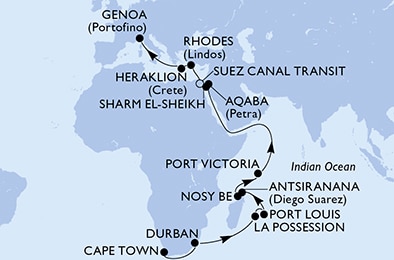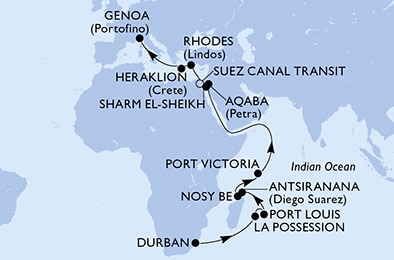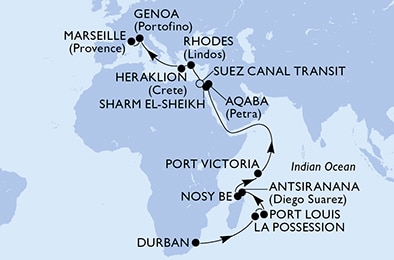
Port Antsiranana (Madagascar)
Antsiranana, also known by its former name Diego Suarez, is a vibrant coastal city located in the northern tip of Madagascar. Renowned for its spectacular natural beauty, Antsiranana is surrounded by scenic bays, rugged landscapes, and unique wildlife. The Bay of Diego Suarez, one of the largest natural bays in the world, features crystal-clear waters dotted with small islets, including the iconic Sugarloaf Island. This makes the region a paradise for beach lovers, snorkelers, and kite surfers.
The city itself is a fascinating blend of French colonial history and Malagasy culture, with its lively markets, colonial-era architecture, and a laid-back atmosphere. It also serves as a gateway to incredible natural attractions, such as the Amber Mountain National Park, known for its lush rainforest, waterfalls, and rare species of lemurs, and the Tsingy Rouge, a breathtaking red sandstone formation unique to the region. With its combination of stunning scenery, outdoor adventures, and cultural richness, Antsiranana is a must-visit destination for those exploring Madagascar's northern treasures.
History
Antsiranana, formerly known as Diego-Suarez, is a historic port city located at the northern tip of Madagascar. The city is named after Diego Diaz and Fernando Suarez, two Portuguese explorers who discovered the area in the early 16th century. Its natural deep-water harbor, one of the largest in the Indian Ocean, made it a key location for maritime trade and military purposes. In the 19th century, the French took control of the region during their colonization of Madagascar, turning Antsiranana into a significant naval base and trade hub.
During the 20th century, Antsiranana played an important role in World War II, serving as a strategic military outpost for the Allies. Following Madagascar's independence in 1960, the city retained its status as a key port and regional center. Today, Antsiranana is celebrated for its breathtaking landscapes, including tropical bays, limestone cliffs, and pristine beaches, as well as for its multicultural heritage, blending Malagasy, French, and Indian Ocean influences. Its strategic location and natural beauty make it a unique destination in Madagascar.








